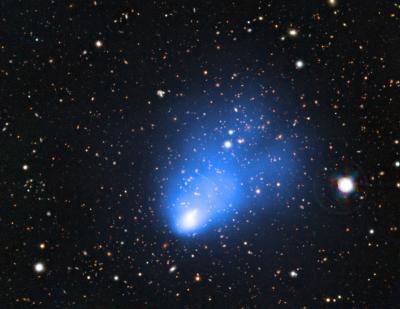The derivation of the formal name shows that it is a galaxy cluster found using data from the Atacama Cosmology Telescope and the second part indicates the location of the object in the sky, in the southern constellation of Phoenix. Clusters of galaxies are the largest objects in the Universe held together by gravity. The process of their formation, when smaller groups of galaxies merge together, very much depends on the amount of dark matter and dark energy in the Universe at that time — so studying clusters can shed some light on these mysterious components of the cosmos.
The team found El Gordo by detecting a distortion of the cosmic microwave background radiation. This faint glow is the remnant of the first light from the Big Bang, the extremely hot and dense origin of the Universe about 13.7 billion years ago. This radiation left over from the Big Bang interacts with electrons in the hot gas in galaxy clusters, distorting the appearance of the background glow seen from Earth. The effect is called the Sunyaev–Zel'dovich (SZ) effect after the Russian astronomers, Rashid Sunyaev and Yakov Zel'dovich who predicted it in the late 1960s. The denser and bigger the cluster, the bigger this effect. El Gordo was picked up in a survey of the microwave background with the Atacama Cosmology Telescope.

This picture of the galaxy cluster ACT-CL J0102-4915 combines images taken with ESO's Very Large Telescope with images from the SOAR Telescope and X-ray observations from NASA's Chandra X-ray Observatory. The X-ray image shows the hot gas in the cluster and is shown in blue. Credit: ESO/SOAR/NASA
ESO's Very Large Telescope was used by the team to measure the velocities of the galaxies in this huge cluster collision and also to measure its distance from Earth. In addition NASA's Chandra X-ray Observatory was used to study the hot gas in the cluster.
Although a cluster of El Gordo's size and distance is very rare, the authors say that the new results are still consistent with astronomers' current understanding of a Universe that started with a Big Bang and is mostly made of dark matter and dark energy.
El Gordo most probably formed just like the Bullet Cluster, a spectacular interacting cluster of galaxies that is almost four billion light-years closer to Earth. In both clusters there is evidence that normal matter, mainly composed of hot, X-ray-bright gas, has been wrenched apart from the dark matter. The hot gas was slowed down by the collision, but the dark matter was not.
"This is the first time we've found a system like the Bullet Cluster at such a large distance," said Cristóbal Sifón, student at the Pontificia Universidad Católica de Chile (PUC) in Santiago. "It's like the old saying: If you want to understand where you're going, you have to know where you've been."






Comments